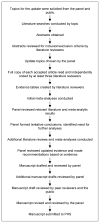A clinical practice guideline for treating tobacco use and dependence: 2008 update. A U.S. Public Health Service report
- PMID: 18617085
- PMCID: PMC4465757
- DOI: 10.1016/j.amepre.2008.04.009
A clinical practice guideline for treating tobacco use and dependence: 2008 update. A U.S. Public Health Service report
Abstract
Objective: To summarize the U.S. Public Health Service guideline Treating Tobacco Use and Dependence: 2008 Update, which provides recommendations for clinical interventions and system changes to promote the treatment of tobacco dependence.
Participants: An independent panel of 24 scientists and clinicians selected by the U.S. Agency for Healthcare Research and Quality on behalf of the U.S. Public Health Service. A consortium of eight governmental and nonprofit organizations sponsored the update.
Evidence: Approximately 8700 English-language, peer-reviewed articles and abstracts, published between 1975 and 2007, were reviewed for data that addressed assessment and treatment of tobacco dependence. This literature served as the basis for more than 35 meta-analyses.
Consensus process: Two panel meetings and numerous conference calls and staff meetings were held to evaluate meta-analyses and relevant literature, to synthesize the results, and to develop recommendations. The updated guideline was then externally reviewed by more than 90 experts, made available for public comment, and revised.
Conclusions: This evidence-based, updated guideline provides specific recommendations regarding brief and intensive tobacco-cessation interventions as well as system-level changes designed to promote the assessment and treatment of tobacco use. Brief clinical approaches for patients willing and unwilling to quit are described.
Figures
References
-
- USDHHS. The health consequences of smoking: a report of the Surgeon General. Atlanta GA: USDHHS, CDC, National Center for Chronic Disease Prevention and Health Promotion, Office on Smoking and Health; 2004.
-
- USDHHS. Reducing tobacco use: a report of the Surgeon General. Atlanta GA: USDHHS, CDC, National Center for Chronic Disease Prevention and Health Promotion, Office on Smoking and Health; 2000.
-
- Baumeister SE, Schumann A, Meyer C, John U, Volzke H, Alte D. Effects of smoking cessation on health care use: is elevated risk of hospitalization among former smokers attributable to smoking-related morbidity? Drug Alcohol Depend. 2007;88(2–3):197–203. - PubMed
-
- Lightwood J. The economics of smoking and cardiovascular disease. Prog Cardiovasc Dis. 2003;46(1):39–78. - PubMed
Publication types
MeSH terms
Substances
Grants and funding
LinkOut - more resources
Full Text Sources
Other Literature Sources
Medical



